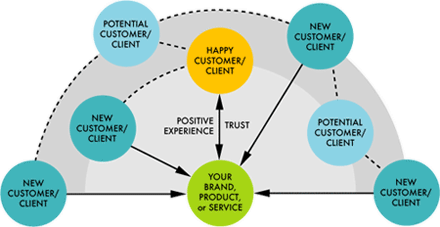Word of mouth, and the concept of marketing it, is certainly not a new idea. Yet, in this age of instant communication, mass media, and more media paths than ever before, the simple concept holds as much power as ever, if not more. In fact, as new forms of communication arise, marketers are discovering new ways of harnessing its power.

Word of mouth, the simple act of consumers sharing information with other consumers, is perhaps the purest, most honest form of advertising in existence. At its core is people’s natural desire to share their experiences with others. Word of mouth cannot be faked or manipulated, and its purity should be respected and protected. The Word of Mouth Marketing Association’s (WOMMA) Code of Ethics provides a wonderful framework for preserving the integrity of word of mouth.
There are many things that businesses can do to build on positive word of mouth and make the most of it -the core goal of word of mouth marketing. Successful (and ethical) word of mouth marketing techniques are based on the principles of customer satisfaction, open & honest dialog, and transparent operations & communications.
WOMMA describes the basic elements as:
- Educating people about your products and services
- Identifying people most likely to share their opinions
- Providing tools that make it easier to share information
- Studying how, where, and when opinions are being shared
- Listening and responding to supporters, detractors, and neutrals
Within these basic elements, WOMMA provides 8 strategies, all of which involve “finding ways to support satisfied customers and making it easier for them to talk with their friends.”
- Encouraging communications
- Giving people something to talk about
- Creating communities and connecting people
- Working with influential communities
- Creating evangelist or advocate programs
- Researching and listening to customer feedback
- Engaging in transparent conversation
- Co-creation and information sharing
These are not one-size-fits-all strategies. When considering incorporating any of these elements into your larger marketing plan, it is best to view them through the lens of your brand and your specific audience. What method fits the message and voice of your business/brand? What are the specific needs of your audience and how do its members talk to each other? Where there is overlap between the answers to these two questions, there lies the most potential for marketing word of mouth.


Excellent post.
Word of Mouth appears to me to still be poorly leveraged in the UK. Moreover I think that the majority of brands that I know of (I work in the tech sector) – are still often damaging their brand by refusing to acknowledge that trusted advise sources are changing – and that peer-to-peer advocacy is increasingly relevant.
Chris from rawstylus.wordpress.com
Hi Chris. Unfortunate indeed. I think those who choose to ignore such changes do so at their own peril. Perhaps, darwinian market forces will eventually force the issue, or at least increase the percentage of companies actively working to monitor these sources.
While information-seekers of all kinds are increasingly turning to search engines, the online channels for “real” information about a brand/product seem to be changing. It seems that consumers are more likely to click on a consumer-generated content rather than company-sponsored content. I think it is a real step in a positive direction…greater transparency across all industries.
Perhaps some reluctance to embrace this change comes from a company’s perceived lack of control over these sources? While these sources cannot be directly controlled,, they CAN be managed. As has alway been the case, brands that stay true to their promises are rewarded by positive word-of-mouth. The difference lies in the fact that now more than ever, those that betray consumers’ trust are held to account in a increasingly public venue. Cheers to that!